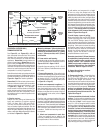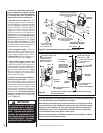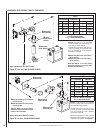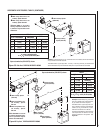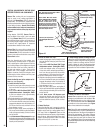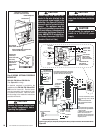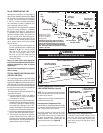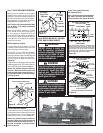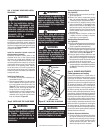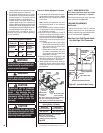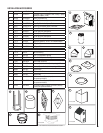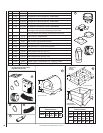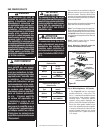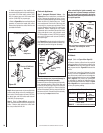
NOTE: DIAGRAMS & ILLUSTRATIONS ARE NOT TO SCALE.
27
Figure 48
TEST ALL CONNECTIONS FOR GAS LEAKS
(FACTORY AND FIELD):
Turn on gas supply and test for gas leaks using a
gas leak test solution (also referred to as bubble
leak solution). Note: Using a soapy water solution
(50% dish soap, 50% water) is an effective leak
test solution but it is not recommended, because
the soap residue that is left on the pipes/fi ttings
can result in corrosion over time.
WARNING
Never use an open fl ame to check for leaks.
Turn on gas supply and test for gas leaks using
a gas leak test solution.
A. Light the appliance (refer to the lighting
instructions label in control compartment
or homeowner's manual).
B. Brush all joints and connections with the gas
leak test solution to check for leaks. If bubbles
are formed, or gas odor is detected, turn the
gas control knob (off/pilot/on) to the “OFF”
position. Either tighten or refasten the leaking
connection, then retest as described above.
C. When the gas lines are tested and leak free be
sure to rinse off the leak testing solution,
D. Turn on burner then observe the individual
tongues of fl ame on the burner. Make sure
all ports are open and producing fl ame evenly
across the burner. If any ports are blocked, or
partially blocked, clean out the ports.
Note:The gas supply line must be installed in
accordance with building codes by a qualifi ed
installer approved and/or licensed as requed by
the locality. In the Commonwealth of Massachu-
setts, installation must be performed by a licensed
plumber or gas fi tter.
Step 6. CONNECTING GAS LINE
Make gas line connections. All codes require a
shut-off valve mounted in the supply line. Figure
47 illustrates two methods for connecting the
as supply. The fl ex-line method is acceptable
in the U.S., however, Canadian requirements
vary depending on locality. Installation must
be in compliance with local codes.
These appliances are equipped with a gas fl ex
line for use (where permitted) in connecting
the appliance to the gas line. A gas fl ex line
is provided to aid in attaching the direct vent
appliance to the gas supply. The gas fl ex line
can only be used where local codes permit.
See Figure 47 for fl ex line description. The fl ex
line is rated for both natural gas and propane
gas. A manual shut off valve is also provided
with the fl ex line.
The incoming gas line should be piped into
the valve compartment and connected (see
Figures 47 & 48). The millivolt control
valve has a 3/8" (10 mm) NPT thread
inlet port. The electronic control valve
has a 1/2" (13 mm) NPT thread inlet port
and is fi tted with a 1/2" x 3/8" (13 mm x
10 mm) NPT fi tting.
Secure all joints tightly using appropriate
tools and sealing compounds (ensure propane
resistant compounds are used in propane
applications).
Optional: Seal around the gas line to prevent
cold air leakage.
Figure 47
Gas
Valve
3/8" NPT x
Flare Fitting
3/8" Flex Tubing
3/8" Nipple
3/8" Union
3/8" Close Nipple
3/8" Shut-off Valve
1/2" x 3/8"
Reducer
Gas
Stub
1/2" x 3/8" Flare
Shut-off Valve
Gas Flex Line Connector
*Sediment Trap
*A Sediment Trap is recom-
mended to prevent moisture
and debris in gas line from
damaging the valve.
3"
Min
.
Gas Valve
Piezo Igniter
Latch for
Glass Door
HI/LO (fl ame height
control knob)
OFF/PILOT/ON (gas control knob)
Gas Flex Line
Optional OFF/ON
Switch Can be
Installed Here
Glass Door is Above
Control Compartment
CONTROL COMPARTMENT ACCESS/LOUVER
PANEL INSTRUCTIONS
(Ref. Figure 49)
NOTE: The top louvered panel and the bottom
louvered control panel door remove and install
the same way as follows:
The gas controls can be found behind the control
compartment access door.
Removing Control Compartment Door:
Open the door by gently lifting it upward until the
hook catches on boths sides clear the locating
slots. Then pull door out to remove.
On millivolt systems, the piezo igniter, HI/LO
fl ame adjustment knob, and pilot and main
gas OFF/ON control knob are located below
the glass panel enclosure. The gas valve for
electronic systems is also located below the
glass enclosure panel. See Figure 48.
Figure 49
OPENING CONTROL
COMPARTMENT DOOR
Control Valve
Lower Control
Compartment Door
Lift the Lower Control
Compartment Door
up and pull out to
remove.
Up
Out
Hook Catch
Reinstalling Control Compartment Door:
To reinstall, insert the hook catches on each
side of the door into the corresponding slots
in the control compartment opening, then
gently push forward and slide down until it
locks in place.
GAS CONNECTION
Control Compartment
Access



